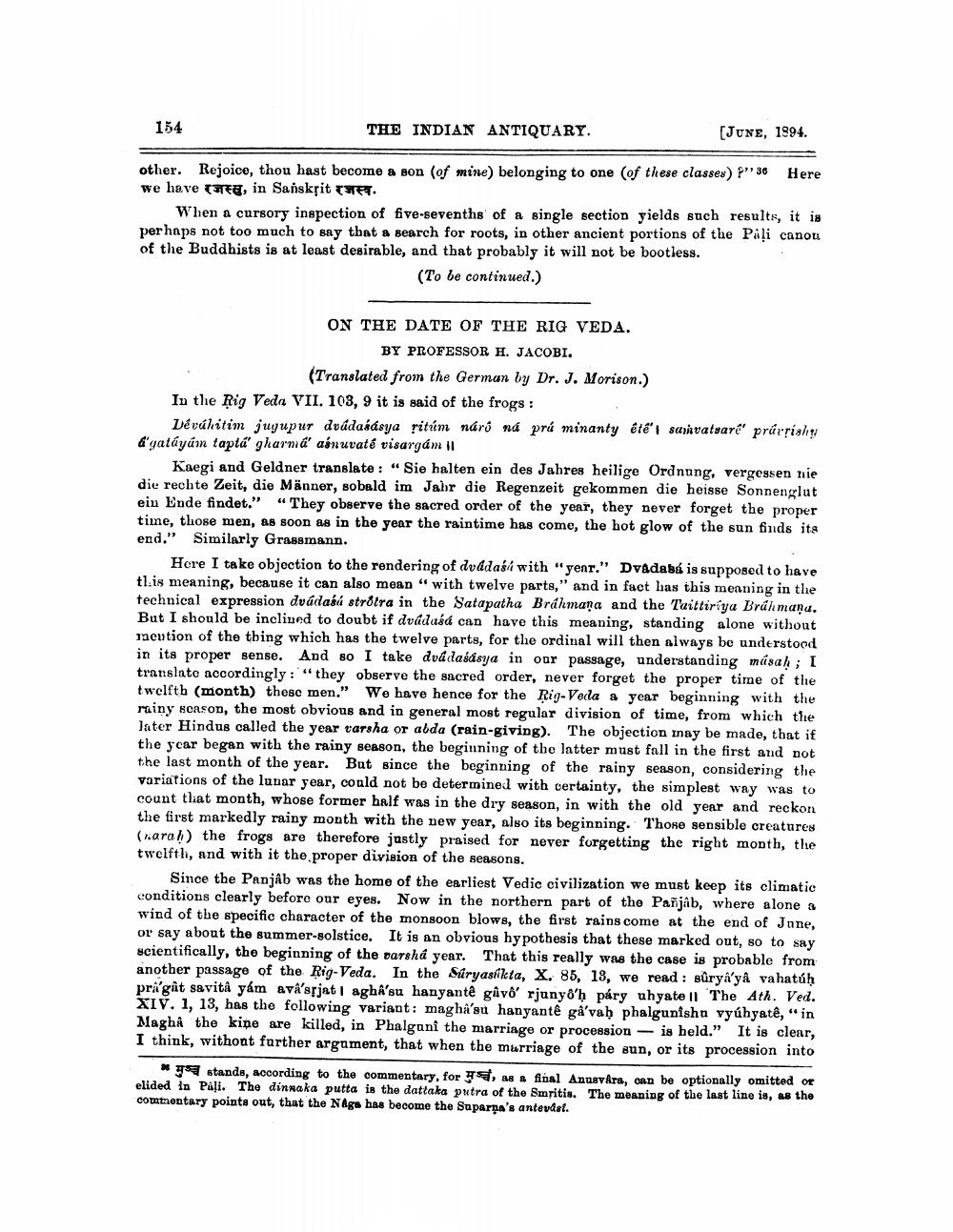________________
154
THE INDIAN ANTIQUARY.
[JUNE, 1894.
other. Rejoice, thou hast become a bon (of mine) belonging to one of these classes) P°'36 Here we have रजस्व, in Sanskrit रजस्व.
When a cursory inspection of five-sevenths of a single section yields such results, it is perhaps not too much to say that a search for roots, in other ancient portions of the Paļi canou of the Buddhists is at least desirable, and that probably it will not be bootless.
(To be continued.)
ON THE DATE OF THE RIG VEDA.
BY PROFESSOR H. JACOBI.
(Translated from the German by Dr. J. Morison.) In the Rig Veda VII. 103, 9 it is said of the frogs:
Dévákitim juyupur dvádasásya ritúm náró ná prú minanty été' I saivatsare' prársishy & gatáyúm taptá' gharna' asnuvaté visargam Il
Kaegi and Geldner translate : “ Sie halten ein des Jahres heilige Ordnung, vergessen nie die rechte Zeit, die Männer, sobald im Jahr die Regenzeit gekommen die heisse Sonnenglut ein Ende findet." "They observe the sacred order of the year, they never forget the proper time, those men, as soon as in the year the raintime has come, the hot glow of the sun finds its end." Similarly Grassmann.
Hore I take objection to the rendering of dvádash with "yenr." Dvadasá is supposed to have tl.is meaning, because it can also mean "with twelve parts," and in fact has this meaning in the technical expression dvádací strotra in the Satapatha Brahmana and the Taittiriya Brahmaņa. But I should be inclined to doubt if dvddasá can have this meaning, standing alone without mention of the thing which has the twelve parts, for the ordinal will then always be understood in its proper sense. And so I take dvádasásya in oor passage, understanding masah; I translate accordingly:"they observe the sacred order, never forget the proper time of the twelfth (month) these men." We have hence for the Rig Vedla a year beginning with the rainy season, the most obvious and in general most regular division of time, from which the Jater Hindus called the year varsha or abda (rain-giving). The objection inay be made, that if the year began with the rainy season, the beginning of the latter must fall in the first and not the last month of the year. But since the beginning of the rainy season, considering the variations of the lunar year, could not be determined with certainty, the simplest way was to count that month, whose former half was in the dry season, in with the old year and reckon the first markedly rainy month with the new year, also its beginning. Those sensible creatures (narah) the frogs are therefore justly praised for never forgetting the right month, the twelfth, and with it the proper division of the seasons.
Since the Panjab was the home of the earliest Vedic civilization we must keep its climatic conditions clearly before our eyes. Now in the northern part of the Pañjab, where alone a wind of the specific character of the monsoon blows, the first rains come at the end of June, or say about the summer-solstice. It is an obvious hypothesis that these marked out, so to say scientifically, the beginning of the barsha year. That this really was the case is probable from another passage of the Rig Veda. In the Súryastikta, x. 85, 13, we read: sürya'yå vahatúh pra'gât savitâ yám avi'spjat | aghi'su hanyantê gûvô rjunyőh páry uhyate 11 The Ath. Ved. XIV. 1, 13, has the following variant: magha'su hanyantê gå'vah phalgunisha vyúhyatê," in Maghỉ the kine are killed, in Phalgani the marriage or procession - is held." It is clear, I think, withoat further argument, that when the marriage of the sun, or its procession into
y stands, according to the commentary, for a final Anusvira, can be optionally omitted or elided in Pasi. The dinnaka putta is the dattaka putra of the Smritis. The meaning of the last line is, as the commentary points out, that the Naga has become the Suparna's antevist.




